
Products
DJI Mavic 3 Multispectral vs DJI Phantom 4 Multispectral
The Mavic 3M is DJI's new multispectral drone for agriculture, land management, and environmental monitoring. Find out how it compares to the DJI Phantom 4 Multispectral and how the Mavic 3M's key upgrades result in more efficient and detai ... Read More

The DJI Mavic 3 Multispectral is an upgraded drone for agriculture, compared to the DJI Phantom 4 Multispectral;
The Mavic 3M has four 5MPs multispectral cameras, compared to the Phantom 4M's five 2MP multispectral camera array;
The visual camera on the Mavic 3M is a 20MP 4/3 CMOS: Superior to the 2MP, 1/2.9" visual sensor on the P4M;
The Mavic 3M's visual camera also has an added mechanical shutter, and the drone has video capture capabilities;
Benefit from the Mavic 3 Multispectral's 43 minutes of flight time, compared to the P4M's 27 minutes;
The Mavic 3M is compact and foldable, making it an easier drone to transport compared to the Phantom 4 Multispectral;
With its longer flight time and enhanced camera capabilities, the Mavic 3M is a more efficient drone, capable of covering up to 2 square kilometers in a single flight;
For all of its upgrades, the Mavic 3M is a more cost-effective option compared to the P4M, making smart ag more accessible for more people.
The Mavic 3M is DJI's new multispectral drone, engineered for precise data collection to benefit precision agriculture, land management, and environmental monitoring.

It builds on the solid foundations laid by the older DJI Phantom 4 Multispectral - unveiled in 2019 - and crucially comes with some stellar upgrades, including an enhanced imaging system and better endurance: All of which help the Mavic 3M collect better quality insights, more efficiently.
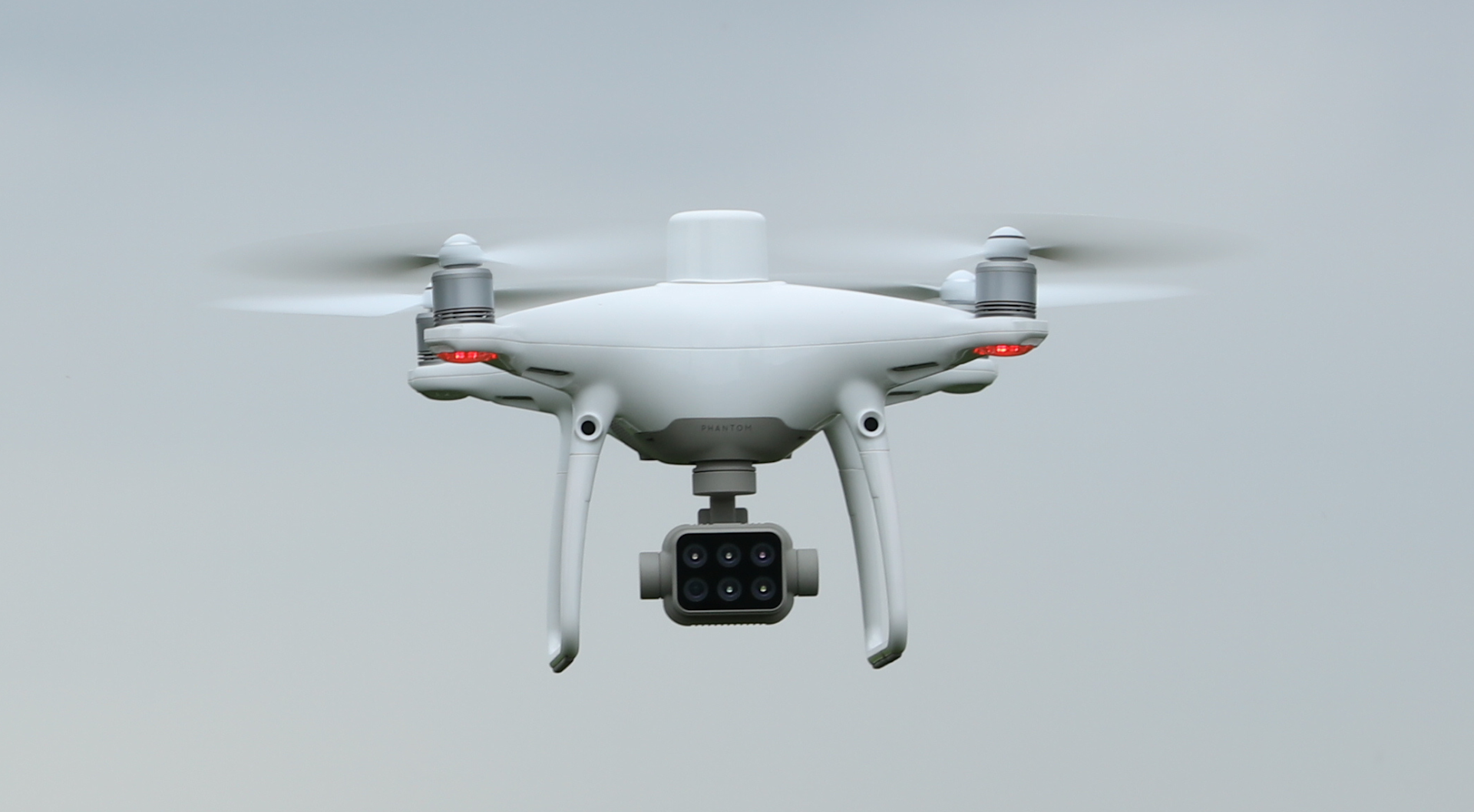
Key upgrades of the Mavic 3M compared to the Phantom 4 Multispectral include:
Drone
The Mavic 3M is lighter and foldable, making it easier to transport
The Mavic 3M has a longer flight time: 43 minutes vs 27 minutes
Multispectral Camera
Increased megapixel size from 2MP to 5MP
Increased gain range from 1x-8x to 1x-32x
Increased FOV from 62.7° to 73.91°
RGB Camera
Increased sensor size from 1/2.9" to 4/3
Increased megapixel size from 2MP to 20MP
Addition of mechanical shutter
4k, 1080p video support added
In this blog, we'll take an in-depth look at these two multispectral drones and demonstrate how the Mavic 3M - which is part of the Mavic 3 Enterprise Series - surpasses the Phantom 4 Multispectral and is a stellar addition to DJI's agricultural drone line-up.
DJI Mavic 3M vs DJI Phantom 4 Multispectral: Key Specifications
The table below provides an overview of the key specifications of both drones.
Mavic 3M | Phantom 4 Multispectral | |
Take-off Weight | 951g; 1,050g (max take-off weight) | 1,487g |
Foldable | Yes | No |
RGB Camera | 4/3 CMOS; 20MP | 1/2.9" CMOS; 2MP |
Multispectral Camera | 4 Bands: Green, Red, Red Edge, Near Infrared; 1/2.8" CMOS; Each camera, 5MP: | 5 Bands: Green, Red, Red Edge, Near Infrared, Blue; 1/2.9" CMOS; Each camera, 2MP |
Max Flight Time | 43 mins | 27 mins |
Operating Temperature | -10°C to 40°C | 0°C to 40°C |
Transmission Distance (CE) | DJI O3 Enterprise; 8km | DJI OcuSync; 5km |
Controller | DJI RC Pro Enterprise smart controller with built-in screen | P4 SDK Remote Controller. No built-in screen: Additional smart device is required. |
Modular | Yes | No |
Current Price | £3,926 (inc VAT) | £5,750 (inc VAT) |
Mavic 3M Vs Phantom 4 Multispectral: Camera
Both drones combine an RGB camera with multispectral cameras to scan and analyse crop growth.
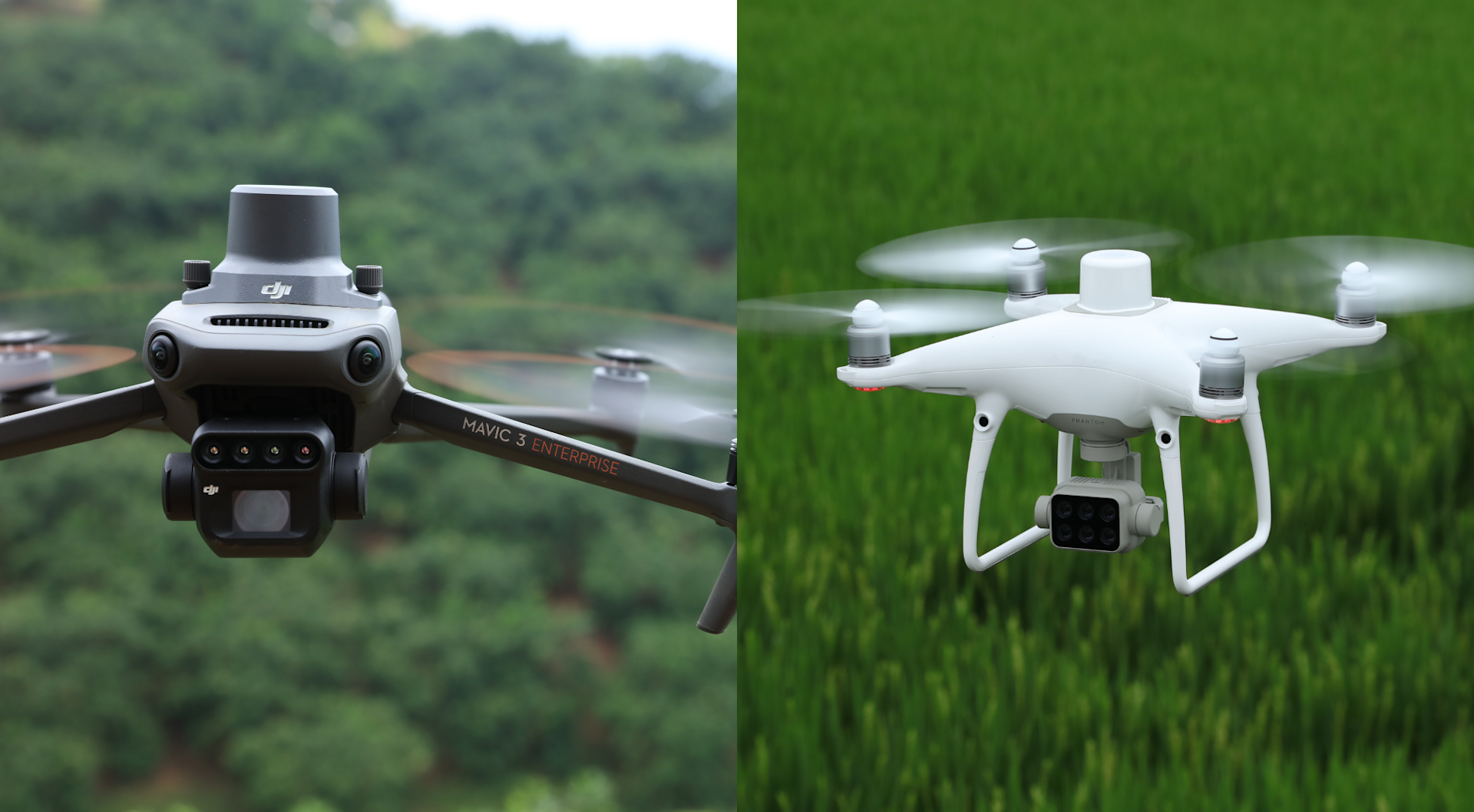
Indeed, the Mavic 3M and P4M are out-of-the-box solutions which enable the collection of streamlined and efficient agricultural imagery.
However, the Mavic 3M has an upgraded imaging system which further streamlines data capture and empowers precision aerial surveying and even greater image clarity.
Multispectral Camera
Multispectral imagery gives agriculture professionals a way to see the invisible and remove the guesswork from day-to-day operations.
By having access to data across specific parts of the electromagnetic spectrum, farmers can build smarter workflows that lower costs, use resources more efficiently, and ultimately maximise yields.
The Mavic 3M and Phantom 4M have a built-in multispectral sensor array, engineered for capturing data at different wavelengths.
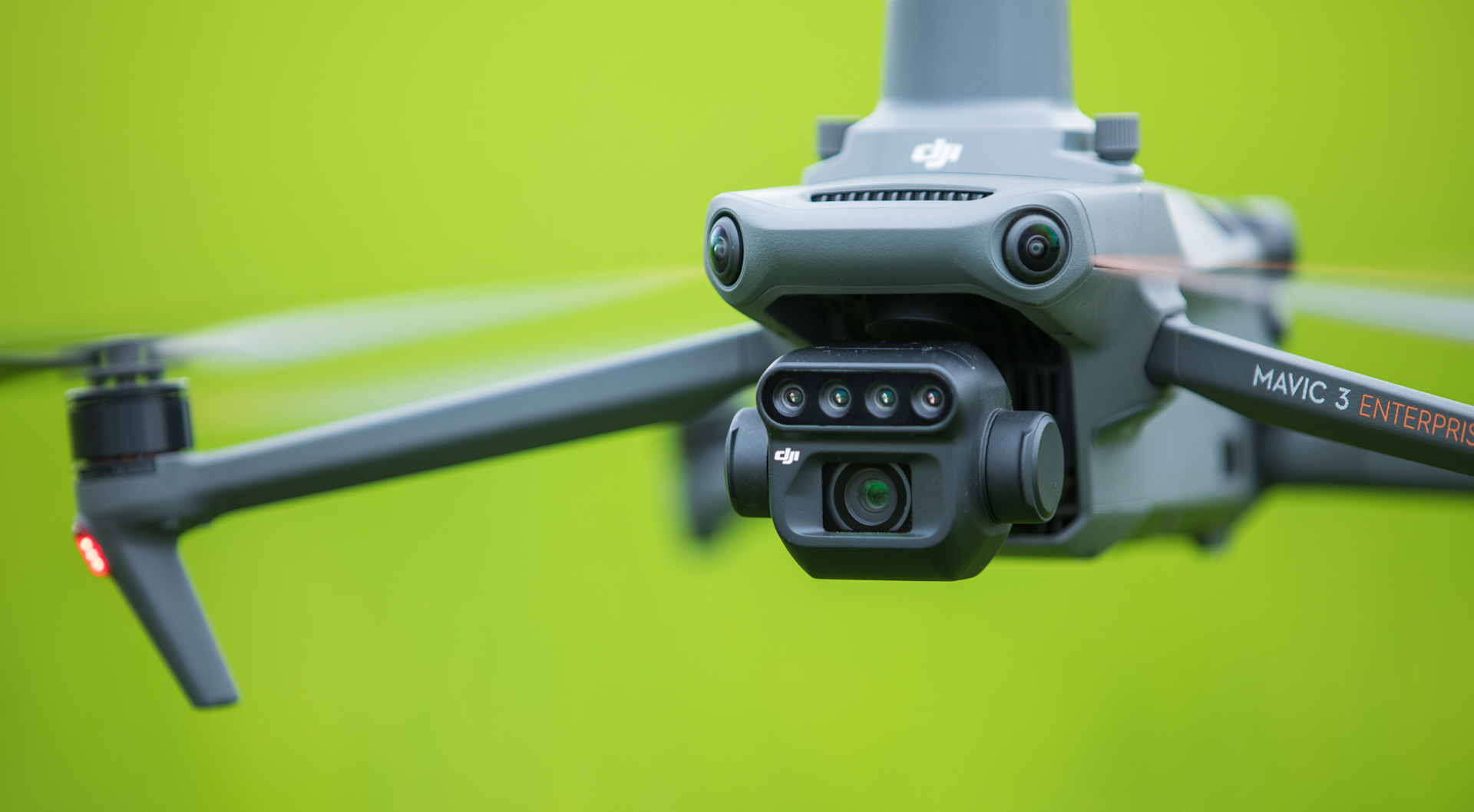
Interestingly, the P4M features five multispectral cameras - Green, Red, Red Edge, Blue, and Near Infrared, while the Mavic 3M as four cameras, omitting the Blue sensor. Quite why DJI did this is not yet clear, but the Mavic 3M is the smallest 4-band multispectral camera in the world, and, as we'll see in this blog, it offers more powerful multispectral data-capture capabilities.
These sensors support the NDVI, GNDVI, and NDRE vegetation indexes to provide farmers with vital information, as outlined by the table below.
Vegetation Index | Insights |
NDVI | Makes it possible to detect plants under stress, differentiate between crops, and determine at which stage they are in their growing cycle. |
NDRE | Provides insights on chlorophyll content in leaves. |
GNDVI | Useful for estimating photosynthetic activity, as well as water and nitrogen content in the plant canopy. |
While the P4M can obtain data in five multispectral wavelengths, compared to the four on the Mavic 3M, the latter has some significant upgrades, such as slightly larger sensors with more megapixels, a wider field of view, a greater gain range, and video capabilities. The Mavic 3M also has an expanded NIR value, from the P4M's 840nm ± 26 nm to 860nm ± 26 nm for slightly improved vegetation and soil imaging.
As an added advantage, Mavic 3M pilots can harness multispectral insights in real-time, thanks to a new feature that shows live vegetation indices in split-screen alongside the visual feed.
In contrast, the Phantom 4 Multispectral does offer live-time views of RGB and multispectral data, but operators are required to switch between these views, instead of a side-by-side view.
The table below compares the drones' multispectral cameras.
Mavic 3M | Phantom 4 Multispectral | |
Multispectral Camera Bands | Four bands: Green (G): 560 ± 16 nm; Red (R): 650 ± 16 nm; Red Edge (RE): 730 ± 16 nm; Near infrared (NIR): 860 ± 26 nm; | Five bands: Green (G): 560 nm ± 16 nm; Red (R): 650 nm ± 16 nm; Red Edge (RE): 730 nm ± 16 nm; Near-infrared (NIR): 840 nm ± 26 nm Blue (B): 450 nm ± 16 nm |
Image Sensor | 1/2.8" CMOS; Effective pixels: 5MP | 1/2.9” CMOS; Effective pixels 2.08MP |
Lens | FOV: 73.91° (61.2° x 48.10°) Equivalent focal length: 25 mm Aperture: f/2.0 Focus: Fixed Focus | FOV (Field of View): 62.7° Focal Length: 5.74 mm (35 mm format equivalent: 40 mm), autofocus set at ∞ Aperture: f/2.2 |
Gain Range | 1x-32x | 1x-8x |
Shutter Speed | Electronic Shutter: 1/30~1/12800 s | Electronic Global Shutter: 1/100 - 1/10000 s |
Max Image Size | 2592 x 1944 | 1600 x 1300 |
Image Format | TIFF | TIFF |
Video Format | MP4 (MPEG-4 AVC/H.264) | N/A |
Video Resolution | H.264 FHD: 1920 x 1080@30fps Video content: NDVI/GNDVI/NDRE | N/A |
Max Video Bitrate | Stream: 60 Mbps | N/A |
RGB Camera
Put simply, the RGB camera on the Mavic 3M is superior to the one on the Phantom 4 Multispectral.
It is larger with more megapixels, has an adjustable aperture and a wider ISO range, and features a mechanic shutter to eliminate rolling image blur. It also comes with added video functionality.
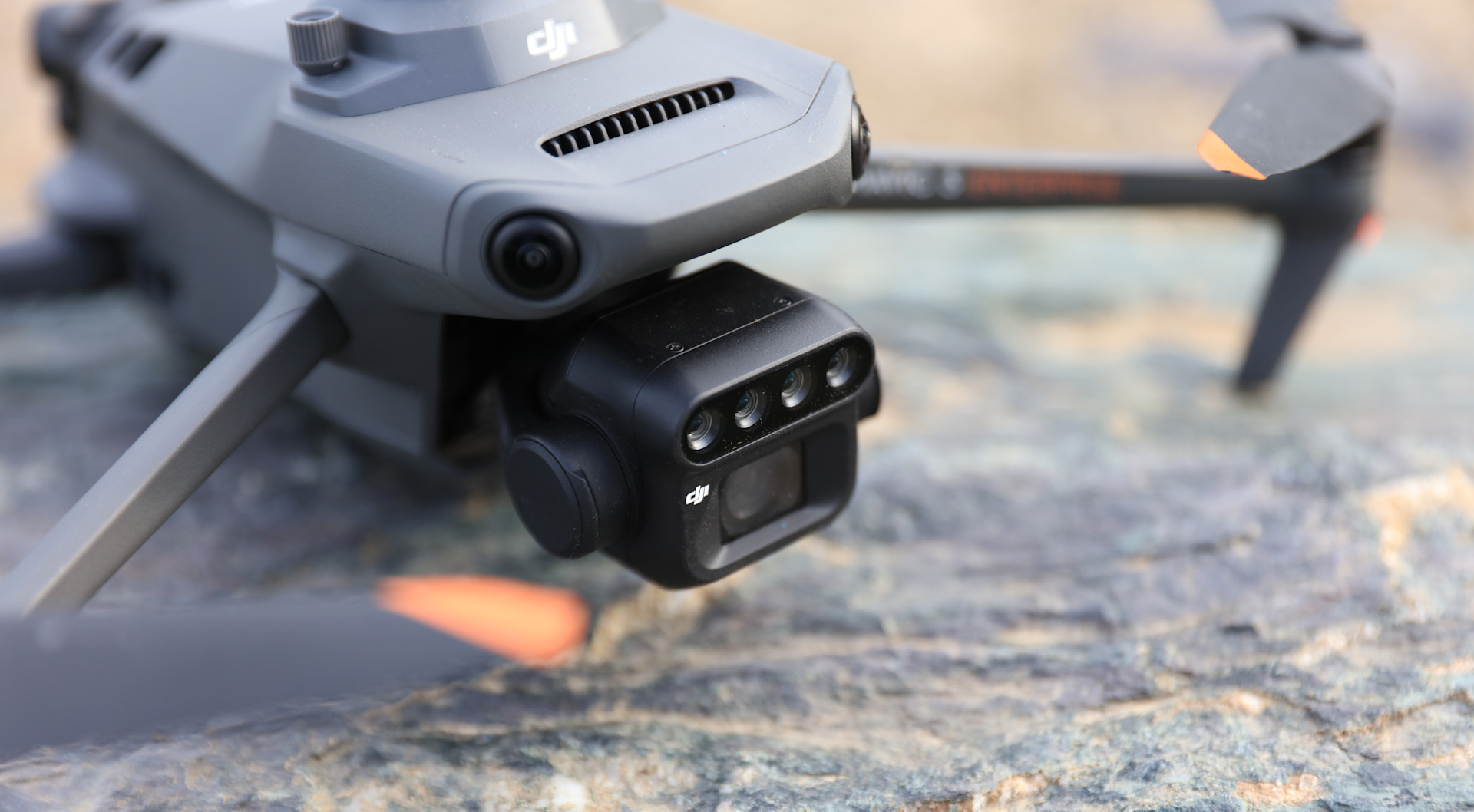
In fact, the Mavic 3M features the same camera as the highly-impressive, surveying-optimised Mavic 3 Enterprise, packing in a 0.7s shooting interval, a larger 3.3μm pixel size, mechanical shutter, and an improved low-light software that offers superb performance in dim conditions.
Pair this with its 43-minutes of flight time, the Mavic 3M can capture data across up to 2 square kilometers in a single flight for enhanced surveying efficiency.
The table below shows the key features of the RGB camera on the M3M and P4M.
Mavic 3M | Phantom 4M | |
Image Sensor | 4/3 CMOS; Effective Pixels: 20MP | 1/2.9" CMOS; Effective Pixels: 2.08MP |
Lens | FOV: 84° Equivalent focal length: 24 mm Aperture: f/2.8 to f/11 Focus: 1 m to ∞ | FOV: 62.7° Focal Length: 5.74 mm (35 mm format equivalent: 40 mm), autofocus set at ∞ Aperture: f/2.2 |
ISO Range | 100-6400 | 200 - 800 |
Shutter Speed | Electronic shutter: 8-1/8000 s Mechanical shutter: 8-1/2000 s | Electronic Global Shutter: 1/100 - 1/20000s |
Max Image Size | 5280 x 3956 | 1600 x 1300 |
Image Format (Visual) | JPEG/DNG (RAW) | JPEG |
Video Resolution | H.264: 4K: 3840×2160@30fps FHD: 1920×1080@30fps | N/A |
Max Video Bitrate | 4K: 130Mbps FHD: 70Mbps | N/A |
Video Format | MP4 (MPEG-4 AVC/H.264) | N/A |
Mavic 3 Multispectral vs Phantom 4 Multispectral: Design
The Mavic 3M and Phantom 4 Multispectral are different in their design.
The principal difference is that the M3M is foldable, while the P4M has the classic fixed Phantom design.
This, coupled with the Mavic 3's lighter weight, makes it a more compact platform - perfect for sliding into a backpack for easy transportation from one site to another.
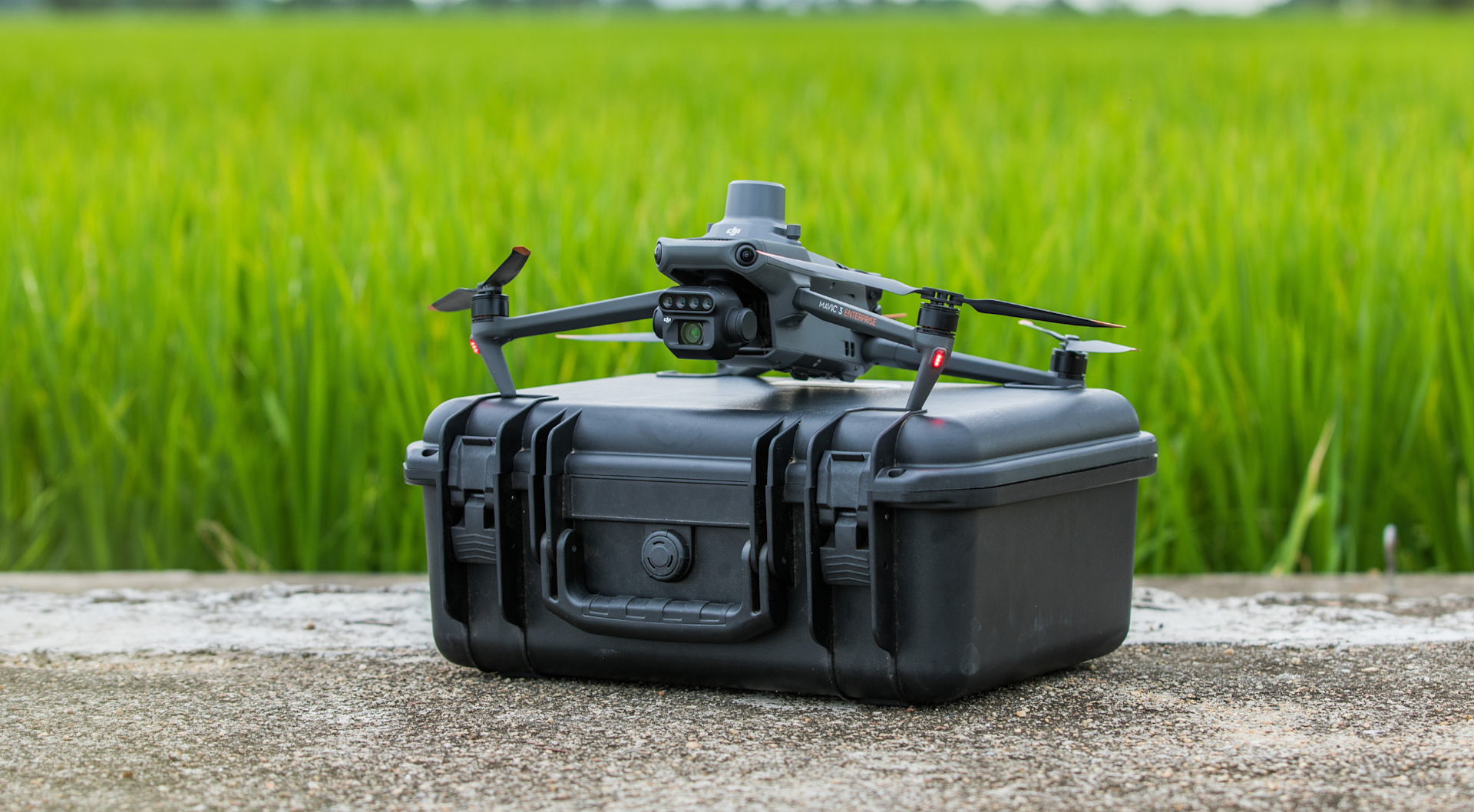
Make no mistake, the Phantom 4M is no monster, but the M3M's reduced footprint aids its portability.
Both drones have fixed payloads, but the Mavic 3M benefits from a modular design which means that various accessories - the RTK Module (which comes with the drone) or a loudspeaker (purchase separately) - can be integrated via the drone's PSDK port on top of the aircraft.
In contrast, the P4M's RTK Module is fixed to the drone.
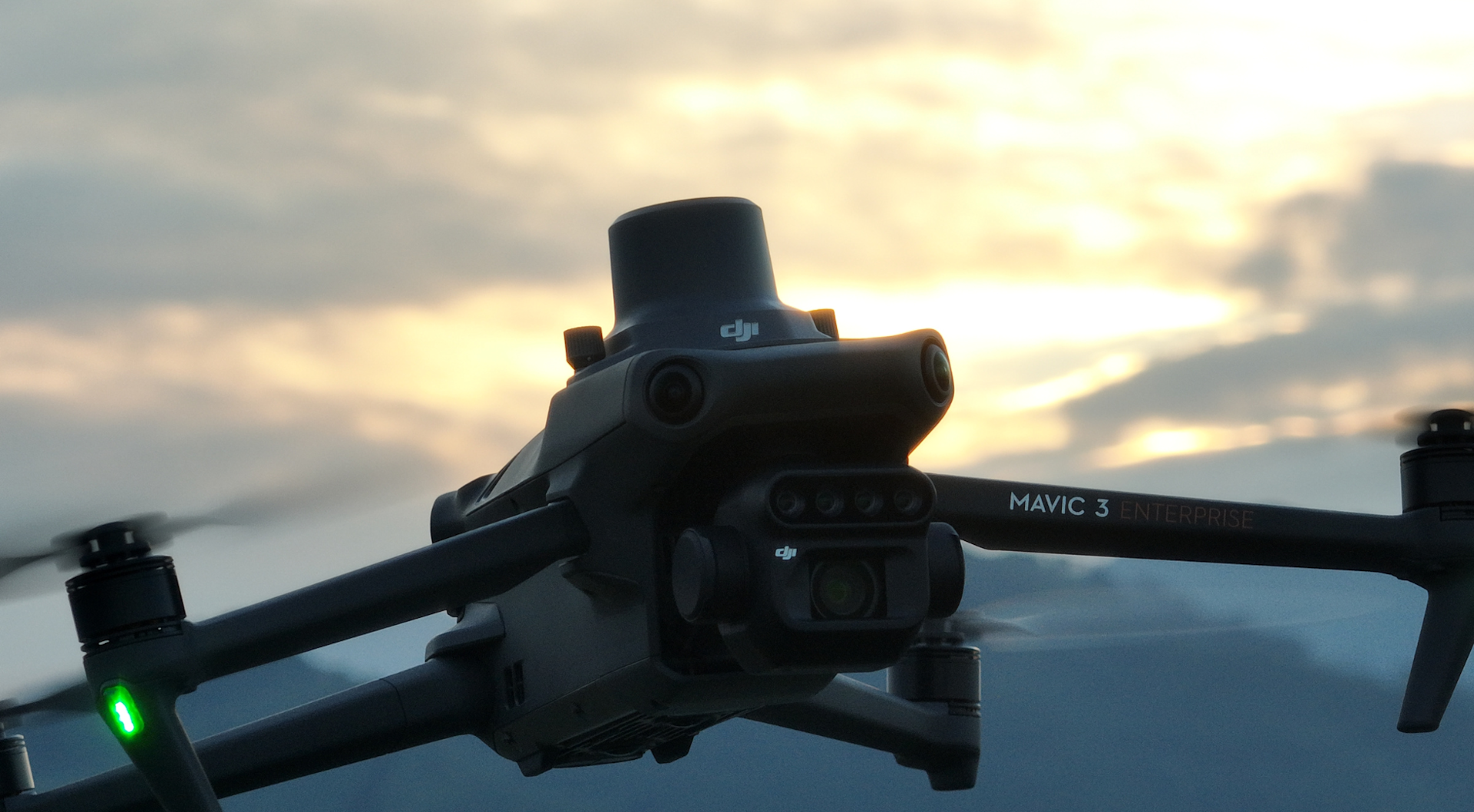
The RTK Module helps real-time, accurate positioning data on images, facilitating centimetre-level positioning. Flight control, the camera, and the RTK module sync rapidly to accurately capture the location of each camera's imaging centre. Especially true of the Mavic 3M, the RTK Modules enables the aircraft to perform high-precision aerial surveying without using ground control points.
Both drones are compatible with the D-RTK 2 Mobile Station, to help enhance the accuracy of RTK positioning without internet connection. This base station is available separately.

The Mavic 3M and Phantom 4 Multispectral come with a sunlight sensor, which captures solar irradiance. This maximises accuracy and consistency of data collection through different times of the day and results in more accurate NDVI results, as well as improved accuracy and consistency of data acquired over time.
Mavic 3 Multispectral vs Phantom 4 Multispectral: Flight Performance
Both drones pack some powerful flight performance features, but the enhanced capabilities of the Mavic 3 Multispectral give it the edge.
For instance, it has a longer flight time, ensuring more data is collected in one flight. It also is a faster and more agile drone, while operators can benefit from a larger transmission distance thanks to the Mavic 3M's compatibility with the upgraded DJI O3 Enterprise transmission system.
The table below provides an overview of the key flight performance features of each drone.
Mavic 3 Multispectral | Phantom 4 Multispectral | |
Flight Time | 43 minutes | 27 minutes |
Max Speed | 33.5 mph (Normal Mode); Flying forward: 46.9 mph, flying sideways: 44.7 mph, flying backwards: 42.5 mph (Sport mode) | 31 mph (P-mode); 36 mph (58 kph) (A-mode) |
Ascent Speed | 6 m/s (Normal Mode) 8 m/s (Sport Mode) | 6 m/s (automatic flight); 5 m/s (manual control) |
Descent Speed | 6 m/s (Normal Mode) 6 m/s (Sport Mode) | 3 m/s |
Operating Temperature | -10°C to 40°C | 0°C to 40°C |
Transmission System | DJI O3 Enterprise | DJI OcuSync |
Transmission Distance (CE) | 8km | 5km |
Smart Terrain Follow
The Mavic 3M offers Terrain Follow, enabling operators to maintain an even altitude as they fly a survey mission across varying terrain. By smoothly adjusting according to the terrain, secure the integrity of the data while it’s gathered, without having to account for any differences in post-processing.
For situations when a DSM or DSM or local elevation data can not be imported pre-flight, the Mavic 3M's collision avoidance sensors can take over by detecting the ground below and automatically adjusting flight height accordingly.
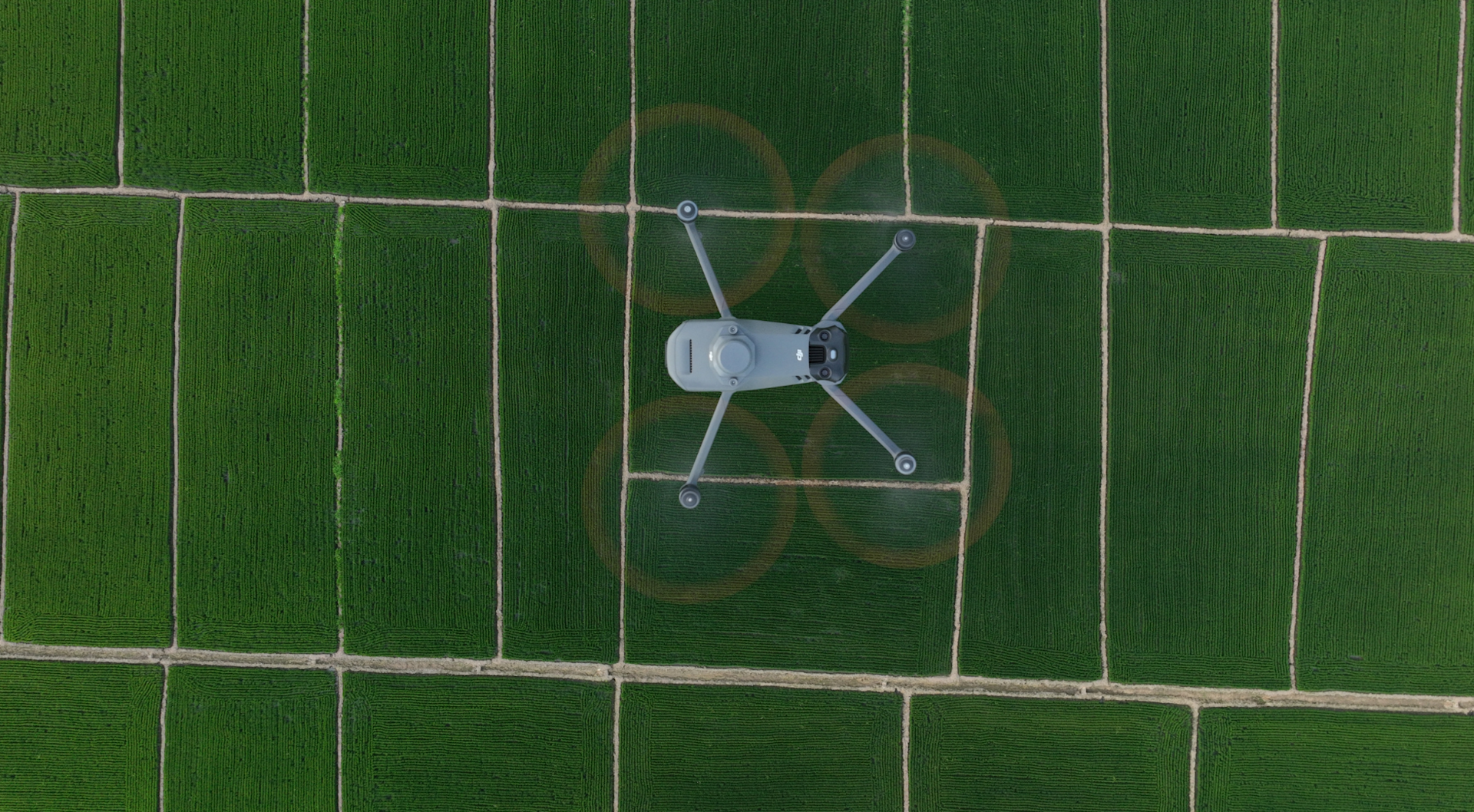
Intelligent Field Scouting
The Mavic 3M can carry out automatic field scouting. The field scout images can be uploaded to the DJI SmartFarm Platform (due to be supported in Q2 2023) in real time through a 4G network.
It can find abnormalities, such as emergence deficiencies, weed pressure, and crop lodging in a timely manner. It can also conduct intelligent analyses, such as cotton seedling identification and rice production testing, using AI identification for real-time sharing of crop growth information, guidance of agronomic activities, and easy management of 70 hectares of farmland by one person.
Mavic 3 Multispectral vs Phantom 4 Multispectral: Safety Features
DJI drones set a high standard when it comes to flight safety.
The Phantom 4 Multispectral has some fairly robust safety features, but the Mavic 3 Multispectral features an enhanced safety suite to provide additional reliability during flights.
For instance, the P4M has a Vision System with the main components located on the front, rear and bottom of the aircraft, while the Infrared Sensing System consists of two 3D infrared modules on both sides of the aircraft.
It also benefits from Return to Home functionality, including Low Battery RTH and Smart RTH (aircraft automatically returns to the last recorded home point).

However, the Mavic 3M comes with enhanced safety features, harnessing the latest in DJI’s safety and transmission technology to reduce the risk of accidents.
Chief among them is state-of-the-art obstacle sensing and navigation powered by DJI's Advanced Pilot Assistance System (APAS 5.0). Data from six vision and two wide-angle sensors are assessed in real-time to detect obstacles in every direction and - when using Avoid mode - reroute your flight path accordingly. APAS 5.0 also powers the Mavic 3M’s advanced Return To Home feature, which optimises your flight path to preserve battery and get your aircraft home safe and sound at the touch of a button.
As with all of DJI’s latest enterprise platforms, the Mavic 3M’s built-in AirSense system provides an early warning of nearby crewed aircraft transmitting ADS-B signals.
Mavic 3 Multispectral vs Phantom 4 Multispectral: Controller
Different controllers are used with the Mavic 3M and Phantom 4 Multispectral.
The Mavic 3M utilises the DJI RC Pro Enterprise smart controller, which comes with built-in screen, whereas the Phantom 4 Multispectral is controlled via the Phantom 4 RTK SDK remote controller, which requires a separate smart device.
One of the big advantages of having a built-in screen is that it is optimised to work in bright conditions.
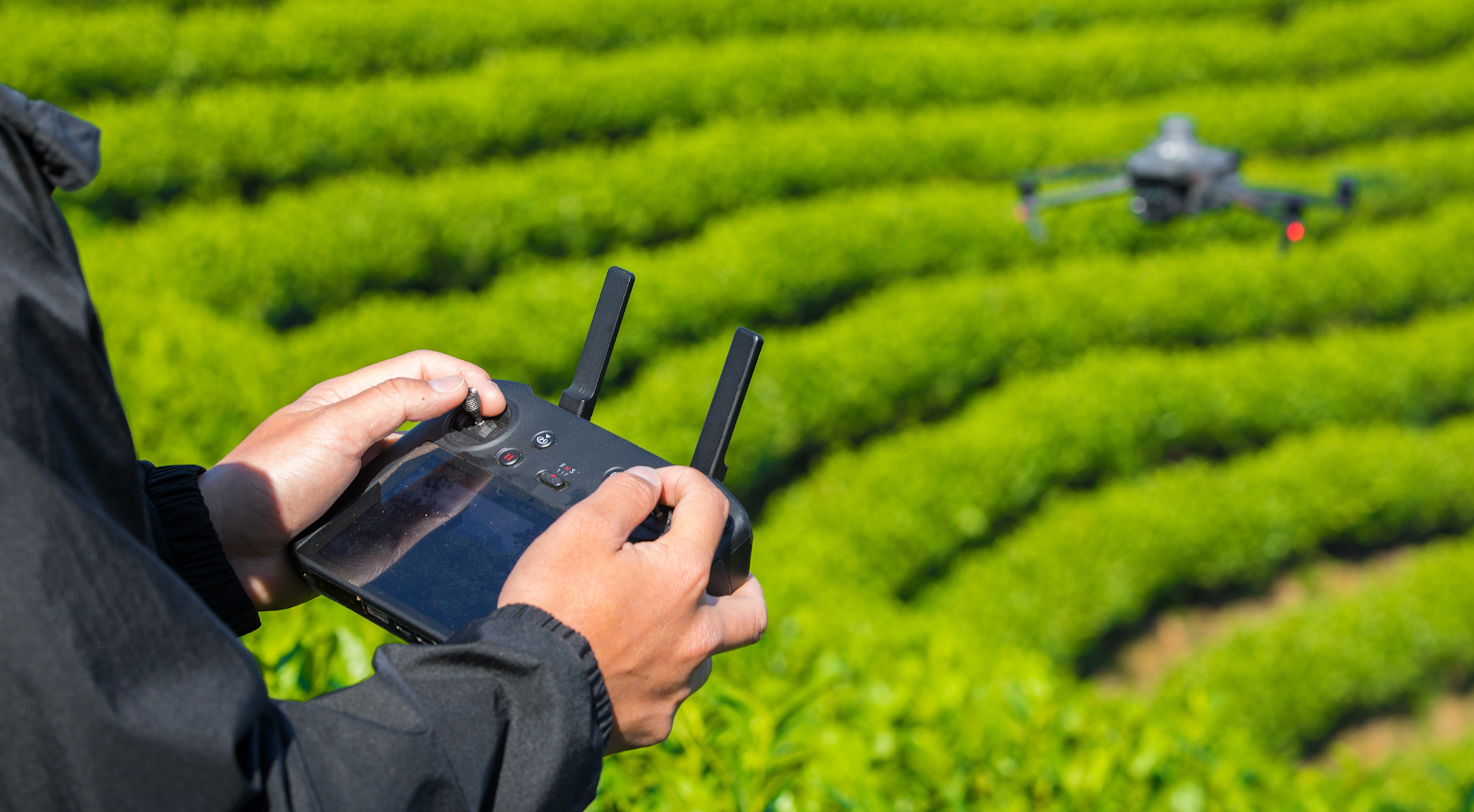
The Mavic 3M supports Mobile SDK 5 (MSDK5) with a fully open-source production code sample. The MSDK5 makes it possible to develop a proprietary control app for UAV field patrol, smart surveying, and other scenarios, making it more user-friendly.
In contrast, the Phantom 4 RTK SDK Remote Controller is Mobile SDK compatible, meaning pilots with experience using third-party applications on DJI drones can access the world's leading drone app ecosystem.
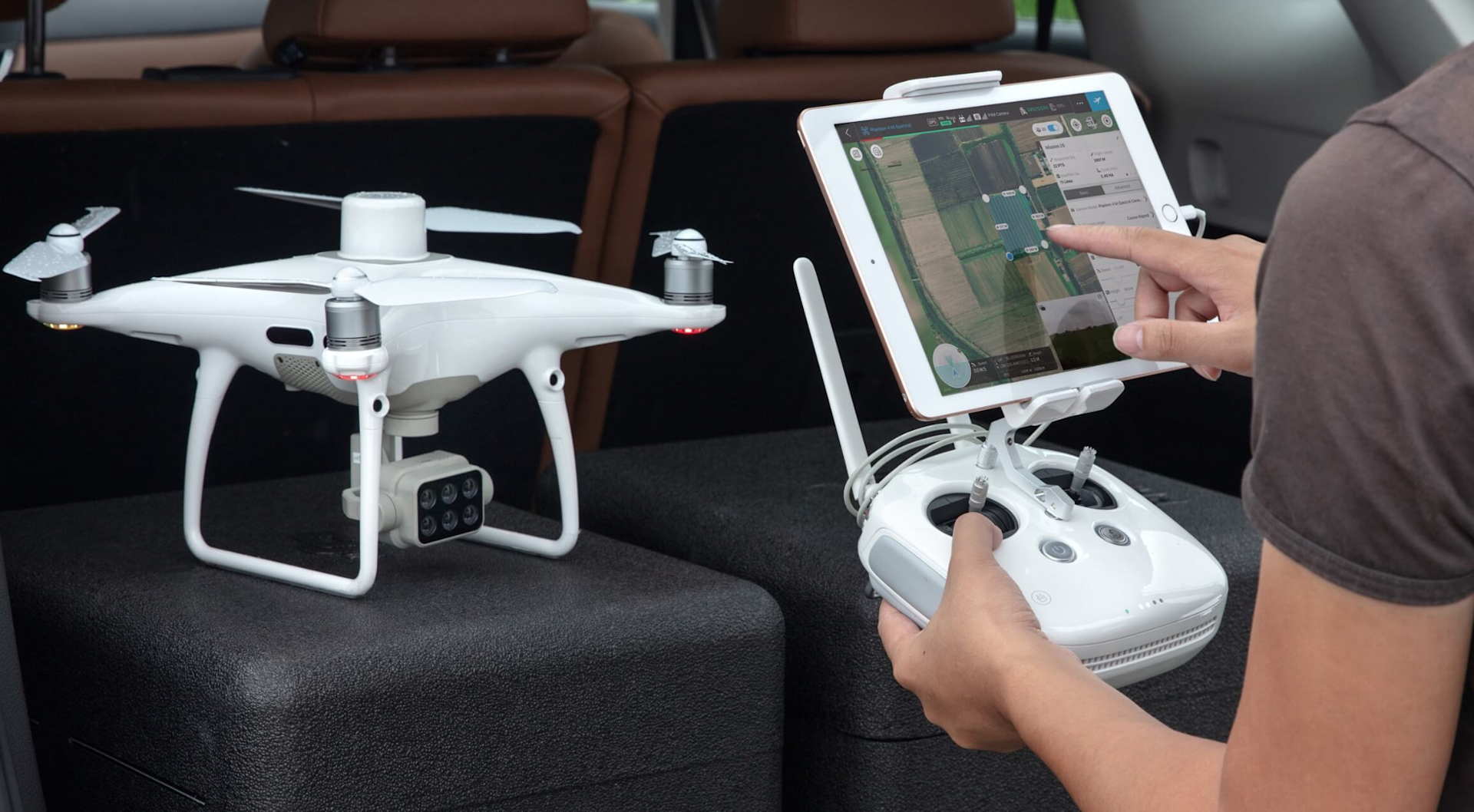
DJI Mavic 3 Multispectral Vs DJI Phantom 4 Multispectral: Price
Another factor to add to the Mavic 3M's appeal is the price. Despite it being DJI's new compact multispectral drone, and packed with stellar upgrades, it is a more cost-effective option than the Phantom 4 Multispectral.
At launch, the Mavic 3M has been priced at £3,926, compared to the Phantom 4 Multispectral, which still carries a price tag in excess of £5,000.
The price, coupled with the Mavic 3 Multispectral's key features, will make multispectral drone applications more accessible for more people, helping greater numbers benefit from DJI's smart agriculture technology.
DJI Mavic 3M Vs DJI P4M: Software Suite
The DJI Mavic 3M and DJI Phantom 4 Multispectral are compatible with DJI Terra to help with agricultural mapping tasks.
DJI has confirmed Mavic 3 Multispectral compatibility with DJI SmartFarm, with support coming in Q2 of 2023.
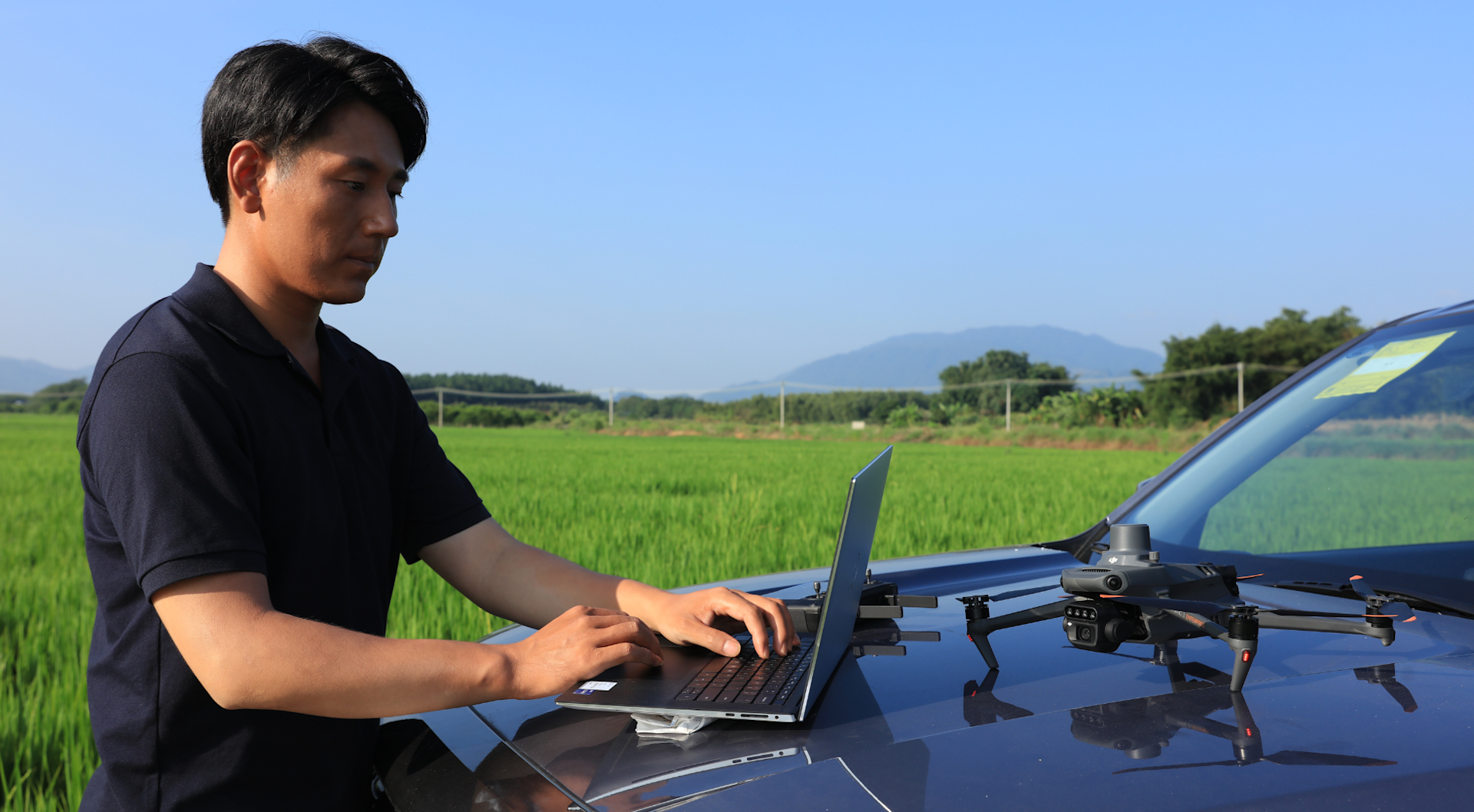
The platform allows agriculture professionals to coordinate any data gathered with spraying and spreading operations.
SmartFarm comes with a range of features for streamlined workflows, including intuitive mission planning, a full fleet overview, field management, data assessment, and effortless collaboration between teams.
DJI Mavic 3M Vs DJI P4M: Summary
Farmers around the world already rely on DJI equipment to plan, manage crop health, and identify issues before they impact bottom lines.
Drones have become a necessary and important tool for boosting efficiency and maximising yields.
And the Mavic 3M is a welcome addition to DJI's agricultural fleet, offering enhanced multispectral and visual data in a compact, foldable platform.
Building on the solid foundations laid by the Phantom 4 Multispectral, the Mavic 3 Multispectral is an upgraded drone which enables accurate and efficient data collection for professionals in agriculture, land management and environmental monitoring.
To add the Mavic 3M to your drone fleet and to discuss drones for smart agriculture, contact the heliguy™ enterprise team.
